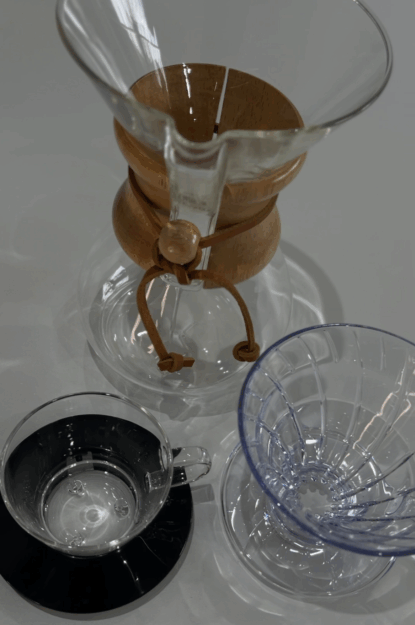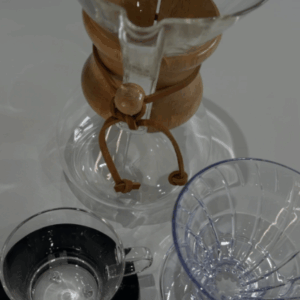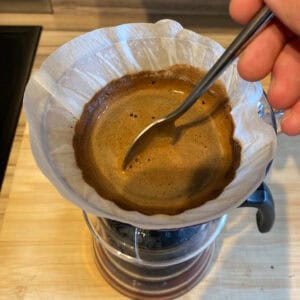Run Out of Coffee Filters? Here’s 5 Substitutes

Filter coffee is one of the most simple, pure and therapeutic forms of coffee brewing. There’s a lot to be said for simply pouring hot water over a carefully curated bed of coffee grounds, and watching it drip through a filter into your cup. But, what should you do if you’re fresh out of filter papers but still want to enjoy a great tasting cup of coffee?
Well, in this article we’ll explore 5 makeshift substitutes you can use to replace coffee filter papers if you’ve run out.
What are Coffee Filter Papers?
Picture the scene. You’ve ground some delicious, freshly roasted coffee beans and boiled your kettle ready to make a pour over coffee. You reach for your coffee filter and bang, you realise you’ve run out and think the whole coffee making process is about to go to waste.
Coffee filter papers are simply the filtration device used to separate ground coffee from the liquid that ends up in your cup. They are often made from paper rather than metallic mesh to strain out as much fine sediment and silt as possible, giving you a clean, smooth and light cup of coffee.
Filter papers are loved by coffee enthusiasts as they remove virtually all of the sediment from the bed of ground coffee, due to the very fine, densely packed holes within them. This allows plenty of delicious, smooth coffee to flow through, without allowing any unwanted silt into your cup.
Coffee filter papers are used in drip brew coffee devices, which use gravity and pouring technique to extract coffee oils into your cup. This is in contrast to immersion brewing (French Press, Cold Brew and AeroPress) or pressure based brewing (Espresso and Moka Pot) which use more drawn out and intense coffee extraction methods respectively.
Whether you use a bleached (white) or unbleached (brown) coffee filter paper is up to you. There is an argument that unbleached coffee filter papers offer a more ‘papery’ taste, but if either of these coffee filter papers are wetted before use, pretty much any residual taste will fade away.
What is Filter Coffee?
Filter coffee is made by pouring hot water over ground coffee and passing the liquid through a fine paper filter, separating the coffee grounds, sediment and fines from the final cup. Coffee oils and dissolved solids are extracted using percolation, as water passes through the bed of coffee and drips down into the drinking vessel below. Filter coffee is therefore also known as ‘drip brew’ coffee, and tends to have a more subtle, clear and nuanced flavour profile than espresso for example.
Filter coffee tends to take a longer time to brew than espresso, due to lower heat and pressure used for extraction. The dose of ground coffee used also tends to be higher than espresso, resulting in a higher caffeine content and a more balanced, but less intense taste.
All coffee brewing methods use some form of filtration to separate the ground coffee from ending up in your cup. However some go about this in a slightly different way than others, allowing a small amount of coffee solids into your cup in the form of silt or residue.
Filter coffee brewing devices include the V60, Chemex, Kalita, Mellita, Clever Dripper, Aeropress (debatable), automatic drip brew machines and Chemex.
All coffee brewing methods use some form of filtration to separate the ground coffee from ending up in your cup. However some go about this in a slightly different way than others, allowing a small amount of coffee solids into your cup in the form of silt or residue.
What to Do if You’ve Run Out of Coffee Filters
First of all, it’s important not to panic or worry if you’ve run out of coffee filters. You can definitely find a way around the problem by using common household items like a sieve, clean cloth or even paper towels.
So, let’s delve into the 5 filter paper substitutes you can use if you’ve run out at home.
5 Coffee Filter Paper Substitutes To Consider
-
Kitchen Sieve
Whilst it is far from ideal, the humble kitchen sieve can be used to strain out coffee grounds from your cup if you’re fresh out of filter papers. The finer sieve you can get the better when it comes to coffee brewing, as you’ll want to separate not only large chunks of ground coffee, but also as many of those tiny ‘fines’ as you can.
Fines are extremely small pieces of ground coffee bean, that will inevitably end up in your coffee bed one way or another. They are often over-extracted (due to their tiny surface area) and are often partially responsible for bitter and astringent tasting notes.
Simply place the fine sieve over a large coffee cup or better still, a wide brimmed jug to make sure you capture all that coffee liquid goodness. Carefully and slowly pour hot water over the coffee grounds, through the sieve and into your coffee container or cup below.
2. Paper Towels
You may struggle to believe that you can actually use a paper towel to make pour over coffee, but it is actually true.
If you’ve run out of filter papers, you can actually use regular kitchen paper towels in your V60, Chemex, drip brew coffee machine or Clever Dripper as a substitute.
Simply fold up your paper towel in half to form a rectangle (end to end). Then, with the open edge facing you (folded edge away from you), go ahead and pull the right hand edge furthest from you into the centre to form a point. Then turn over the paper towel and do the same on the other side so you now have a triangular shape. This will form a cone when you press the middle section out, and hey presto, you now have a makeshift coffee filter paper ready to use.
This video by Team Lynch Spirit of Adventure shows the folding technique described above with a Chemex filter paper, so check out his video below for a visual demonstration:
A word of warning if you end up going with the paper towel option; the composition of materials used to make paper towels could well alter the taste of your cup of coffee, so bear this in mind when going down this route. Coffee filter papers are specifically designed to have minimal impact on the flavour in your cup, whereas paper towels are not.
You can pre wet your paper towel filter to mitigate the impact of the coffee taste being altered, but this will only work to a limited extent.
3. Clean Cloth
A more traditional and less taste inhibiting alternative to coffee filter papers is a clean kitchen cloth or teatowel. This is a great option if you have a freshly cleaned tea towel or kitchen cloth to hand, but naturally will create more mess and washing as a result.
Bear in mind that the thickness of your cloth will impact the flow rate of your coffee, so adjust your coffee and water ratios accordingly. You may need to grind slightly finer and add more water when using a thicker cloth, whereas grinding finer and using a lower quantity of water could well balance out the flow rate when using a thinner cloth.
Simply place the cloth in your pour over coffee device of choice, add your ground coffee and slowly pour over your desired quantity of hot water.
4. A New Cotton Sock
Now this may sound a little crazy, and I’d only really recommend this option if you’re desperate, but you can indeed use a clean sock as a means of filtering coffee…
Now by this point I would have simply ventured to my local coffee shop quite frankly, but if you really want to avoid wasting perfectly good coffee and are in dire need of a caffeine fix, then this could be an option worth considering.
I’d recommend using a single, brand new or at the very least freshly cleaned sock (preferably dark in colour so you don’t go and stain a crisp white one). You’ll want a fairly coarse grind for this method if you can help it, and you actually have a couple of different brewing methods available to you.
Firstly, you can take the cowboy style immersion brewing method, which involves adding coarsely ground coffee to your sock, tying a knot in the top and effectively using it like a tea bag to steep the coffee grounds in hot water. Agitate and leave to brew for 5-10 minutes and you’ll have yourself a perfectly drinkable cup of coffee.
On the other hand, you could cup open the sock and use it as a filter in its own right, much like you would do with a cloth as described above. You can lay the sock over your chosen coffee brewing device, add your coffee grounds and pour over hot water to produce ‘filter’ coffee.
5. Napkin
The final filter paper substitute on this list is the humble napkin.
A napkin can bridge the gap between the cloth and the paper towels, depending on whether you’re using a paper or cotton napkin. Either way, you can follow a similar method in terms of folding and wetting your makeshift filter as the above.
Ensure the napkin fits your pour over coffee equipment, regardless of whether it’s paper or cotton based for the best results.
Summary
Overall, running out of coffee filter papers can be a stressful experience, but it doesn’t have to turn into a disaster. With these useful makeshift filter paper substitutes, you can savour every last drop of your favourite home brewed coffee.
I’d recommend taking things slow and only using these methods as a last resort, as you don’t want to brew a nasty tasting cup, or end up with a coffee grounds implosion all over your kitchen counter.
Either way, hopefully these methods of coffee filter paper substitutes can get you out of trouble if you do end up running out of them!
Coffee Filter Paper Alternatives Frequently Asked Questions
No, coffee filter papers are specifically designed to fit certain drip brew devices, such as the V60, Chemex, Clever Dripper, Kalita and Melitta. Double check the size of your specific brewer to ensure you are getting not only the correct size filter papers, but also the right shape as well.
Yes, it’s perfectly possible to make filter coffee using paper towels rather than filter papers. Whilst it may give your brew a slightly altered flavour due to the component materials used to make paper towels, as a last resort you can fold your kitchen paper in the same way you would a chemex filter and use it as a makeshift solution.
Filter coffee is made by pouring hot water over a bed of coffee grounds, sitting on top of a coffee brewing device such as a V60, Chemex, Kalita or even a drip brew machine basket.
Filter papers or mesh filters separate the coffee grounds from your cup, allowing you to extract those essential coffee oils without ending up with a load of grit or sediment in your teeth.



